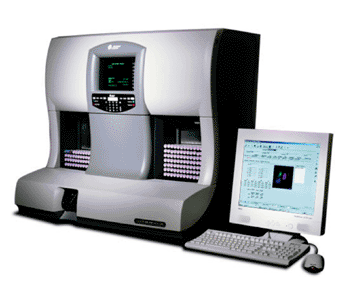Potential Hematological Parameter Proposed for Viral Infections
By LabMedica International staff writers
Posted on 29 May 2013
A hematology analyzer with volume, conductivity, and light scatter (VCS) technology can determine morphologic properties of peripheral leukocytes, known as cell population data (CPD).Posted on 29 May 2013
Lymphocyte CPD exhibit significant changes in acute hepatitis B virus infection and a simplified lymph index has been proposed and evaluated in patients with various viral infections, as well as those with acute bacterial infections.

Image: LH750 hematology analyzer (Photo courtesy of Beckman Coulter).
Scientists at Nantong University (China) carried out a retrospective case-control study, collecting peripheral venous blood samples from a total 322 individuals from June to December 2011. From the study group, 72 patients had viral infections, 46 patients had acute bacterial infections, and 204 normal healthy controls were also tested. The various viral infections included respiratory syncytial virus, adenovirus, coxsackie virus, Epstein–Barr virus, and Hepatitis B virus. The acute bacterial infections included Klebsiella pneumoniae, Escherichia coli, Pseudomonas aeruginosa, Acinetobacter baumannii, Streptococcus pneumoniae, Neisseria gonorrhoeae, and Proteus.
The CPD of lymphocytes and neutrophils, which were generated by each individual cell passing through the aperture were optically and electronically measured by the Coulter LH750 (Beckman Coulter; Brea, CA, USA). Viral serologic tests were performed using an ALISEI enzyme immune analyzer (SEAC; Florence, Italy). Bacterial cultures were performed using a VITEK-32 microbiological culture analyzer and the identification card (bioMérieux; Lyon, France).
The lymphocyte CPD included the mean volume (LV) with its standard deviation (LV-SD) and the conductivity (LC). The lymph index was calculated as LV × LV-SD ÷ LC. The lymph index for 204 healthy controls had a mean white blood cell count (WBC) of 6.3 × 109/l, a mean of 56%, neutrophils and a mean of 34% lymphocytes. The 72 patients with viral infections had a mean WBC of 6.0 × 109/L, a mean of 54% neutrophils of and a mean of 37% lymphocytes. The patients with bacterial infections had a mean WBC of 11.7 × 109/L, with a mean of 79% neutrophils of and a mean of 15% lymphocytes.
The lymph index was significantly increased in viral infections and only mildly increased in acute bacterial infections compared to controls. Using a lymph index cutoff value of equal to or greater than 12.92, the investigators achieved 91.67% sensitivity and 97.2% specificity for diagnosing viral infection. The findings may be clinically useful since these morphological parameters are readily obtained by hematology analyzer during automated leukocyte differentials and there is no additional cost.
The study was published in the July 2013 issue of the International Journal of Infectious Diseases.
Related Links:
Nantong University
Beckman Coulter
SEAC














